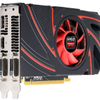AMD Radeon R7-265 Slash Radeon HD 7850
Them Islands Again
Over the past two years you have been hearing about several codenames and that can be a little confusing. It's simple really, in the market we have entry level, mainstream and high-end products. When you notice "Cape Verde" that's entry level, such as the current 7700 series. Pitcairn would be the codename the mainstream products like the 7800 hide under, and Tahiti is the codename for the GPUs used on AMD's most high-end graphics cards. The R7-265 is Pitcarn Pro (Radeon HD 7850).
- Entry level = Cape Verde = Radeon HD 7700 series / R5 series
- Mainstream level = Pitcairn / Bonaire / Curacao = Radeon HD 7800 series / R7 series
- High-end level = Tahiti = Radeon HD 7900 series / R9 series
- Enthusiast level Hawaii = R9-290 and 290X
The entire segment from top to bottom was released in Q1 2012, but most of the 2013 models are respins, the exception being the R7 260 and 260X and the R9-290/290X graphics cards.
R7-260
- Stream Processors 768
- Clock Frequency up-to 1.0 GHz
- 1.54 TFLOPS compute performance
- 1 GB memory at 6.0 Gbps / 128-bit
- 95W TDP
- PCI-E 3.0
- API - DirectX 11.2 / OpenGl 4.3 / Mantle
R7-260X
- Stream Processors 896
- Clock Frequency up-to 1.1 GHz
- 1.97 TFLOPS compute performance
- 2 GB memory at 6.5 Gbps / 128-bit
- 115W TDP
- PCI-E 3.0
- API - DirectX 11.2 / OpenGl 4.3 / Mantle
R7-265 (previously the R7850 GHz / Pitcairn)
- Stream Processors 1024
- Clock Frequency up-to 925 MHz
- 1.89 TFLOPS compute performance
- 2 GB memory at 5.6 Gbps / 256-bit
- 150W TDP
- PCI-E 3.0
- API - DirectX 11.2 / OpenGl 4.3 / Mantle
R9-270X (previously the R7870 GHz / Pitcairn)
- Stream Processors 1280
- Clock Frequency up-to 1.05 GHz
- 2.69 TFLOPS compute performance
- 2 or 4 GB memory at 5.6 Gbps
- 180W TDP
- PCI-E 3.0
- API - DirectX 11.2 / OpenGL 4.3 / Mantle
As stated, the R7-265 is based off Pitcairn Pro, you guys know this GPU as Radeon HD 7850. AMD bakes the GPU on a 28nm node, in very simple wording that means they can put more transistors on a smaller processor die area, typically resulting in less power consumption as well. The Radeon R7-265 / HD 7800 / Pitcairn graphics core has a good 2.8 Billion transistors. Memory wise the R7-265 card in it's reference design will pack 2 Gigabyte of DDR5 memory.
The memory bus is 256-bit, but combined with the GDDR5 memory (which is quad data rate) you do get a decent chunk of much needed memory bandwidth, which the GPU certainly can use. The memory clock will be 1200 MHz, being quad data-rate (GDDR5) that results in an effective data rate of 4800 MHz or 4.8 GHz. This will give the graphics card 154 GB/sec of framebuffer bandwidth to do its thing in. The GPU packs 2.8 billion transistors, but if you can't apply a fast enough clock frequency it would become a problem. Well, that's not an issue for AMD either, the R7-265 is clocked at 925 MHz.




